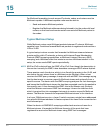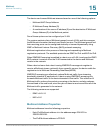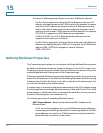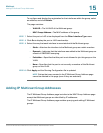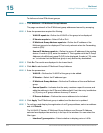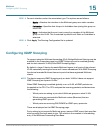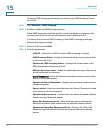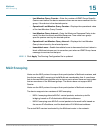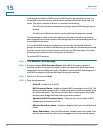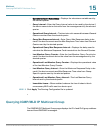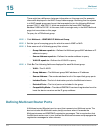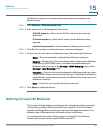
Multicast
Configuring IGMP Snooping
Cisco Small Business 200 Series Smart Switch Administration Guide 214
15
STEP 8 For each interface, select its association type. The options are as follows:
• Static—Attaches the interface to the Multicast group as a static member.
• Forbidden—Specifies that this port is forbidden from joining this group on
this VLAN.
• None—Indicates that the port is not currently a member of this Multicast
group on this VLAN. This is selected by default until Static or Forbidden is
selected.
STEP 9 Click Apply. The Running Configuration file is updated.
Configuring IGMP Snooping
To support selective Multicast forwarding (IPv4), Bridge Multicast filtering must be
enabled (in the Properties page), and IGMP Snooping must be enabled globally
and for each relevant VLAN (in the IGMP Snooping page).
By default, a Layer 2 device forwards Multicast frames to all ports of the relevant
VLAN, essentially treating the frame as if it were a Broadcast. With IGMP Snooping
the device forwards Multicast frames to ports that have registered Multicast
clients.
NOTE The device supports IGMP Snooping only on static VLANs. It does not support
IGMP Snooping on dynamic VLANs.
When IGMP Snooping is enabled globally or on a VLAN, all IGMP packets are
forwarded to the CPU. The CPU analyzes the incoming packets, and determines
the following:
• Which ports are asking to join which Multicast groups on what VLAN.
• Which ports are connected to Multicast routers (Mrouters) that are
generating IGMP queries.
• Which ports are receiving PIM, DVMRP, or IGMP query protocols.
These are displayed on the IGMP Snooping page.
Ports, asking to join a specific Multicast group, issue an IGMP report that specifies
which group(s) the host wants to join. This results in the creation of a forwarding
entry in the Multicast Forwarding Data Base.




